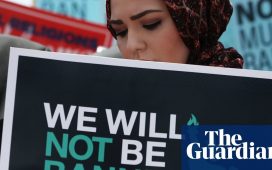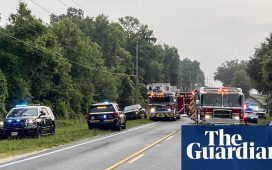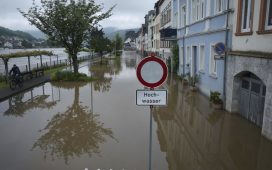As Rosalba Garcia climbed into a wooden boat loaded with 55 people in the middle of the night, she was terrified. The 37-year-old was about to embark on a treacherous journey across a notorious 80-mile stretch of sea between the Dominican Republic and Puerto Rico known as the Mona Passage. Fraught with strong currents and huge waves, many who undertake the perilous journey never make it ashore.
With only the clothes she was wearing, little money and no papers, Garcia’s only thought as she embarked was to find her 21-year-old son, who had made the same journey two years before, and secure work that would allow her to provide for her two other children and parents back home.
“The journey was unbelievable,” she says. It lasted four days. One of the motors of the yola – the name given to the small boats used by people to cross the Mona Passage – stopped working and the sea turned rough. “All I could do was ask God to let me see my son again, and to not let me drown there,” says Garcia.
Garcia is typical of the thousands of Dominicans each year who arrive in Puerto Rico, a US territory in the Caribbean, by boat and without a visa. “People come with their mind fixed on making money. They work 12 to 13 hours a day,” says José Rodríguez, president of the Dominican committee for human rights in Puerto Rico.
“Sometimes they have family to support in Puerto Rico and the Dominican Republic. Some go on to the US but many stay here, because almost everything is the same – the language, the culture, the food and the weather.” Rodríguez adds that whatever their immigration status, individuals have been able to get a driving licence and a bank account since 2014.
It is impossible to know how many undocumented people there are in Puerto Rico. According to census figures, the Dominican population – the largest immigrant group on the island – was 58,352 in 2021; close to 60% were women. A 2023 report by the Dominican Studies Institute at City College of New York estimated the real number to be closer to 80,000, given that the census had not been effective in counting immigrant communities – especially undocumented people. Some say there may be as many as 200,000 Dominicans on the island.
Although most of those who make the journey by sea are Dominicans, increasing numbers of Haitians are coming to escape gang violence and deepening poverty, as are Venezuelans, Kazakhs, Albanians and Colombians.
Once in Puerto Rico, it is fairly easy to find work and slot into the informal economy, which some studies estimate may account for as much as 30% of the island’s gross national product. Many find work in construction, in people’s homes as carers or domestic workers, and in hairdressers, beauty salons and restaurants. Many go on to launch their own businesses.
Euclide Hernandes, 49, arrived in 2003 by yola. A barber by trade, he found work cutting hair when a Dominican woman allowed him to rent a space in her salon. She never asked whether he had a legal right to work in Puerto Rico.
For 13 years, he worked 12 hours a day, seven days a week to make enough to support his wife and three children who had come to Puerto Rico legally before him, and his father and four siblings in the Dominican Republic. He got residency in 2014, and opened his own barber shop with the money he had saved. A couple of years later he started two money transfer businesses.
“I did it through hard work and dedication,” he says. “It’s not hard to find work here, because [the Dominican community gives you opportunities]. Puerto Ricans have also given us a helping hand.” Like the woman who helped him, Hernandes also takes on employees who came by boat and lack work papers.
The Dominican population on the island peaked in 2010. Since then, Puerto Rico has been battered by hurricanes, earthquakes, and a devastating financial and economic crisis that led the government to bankruptcy.
The Puerto Rican economy appears to have turned a corner, according to the Dominican Studies Institute report, propelled by the end of the government’s bankruptcy proceedings and an influx of federal funding already assigned as part of economic recovery packages linked to the recent hurricanes and earthquakes. There are forecasts of labour shortages in various sectors, including construction, services and commerce.
Rodríguez believes these gaps in the workforce are leading to a rise in the number of people coming to Puerto Rico by boat. He also thinks the situation suits the US government. “I suspect that in the long term, [authorities] are letting these journeys happen because it’s a form of slavery. [These people] are helping in the reconstruction of Puerto Rico without being paid any benefits, like social security.”
The US Coast Guard, which conducts search and rescue missions out of Aguadilla, in the north-west of the island, has a different message. “We call to people considering this type of voyage to not take to the sea. It is just not worth it,” says Ricardo Castrodad, the US Coast Guard’s San Juan sector public affairs officer. “You’re going to risk your life and be interdicted.”
From 1 October 2022 to 31 January 2024, the Coast Guard stopped 91 boats carrying 2,941 people, in the waters between the Dominican Republic and Puerto Rico. On a Coast Guard helicopter flight in January, the sea looked calm, but waves can reach up to a “pretty significant” six metres high, according to pilot Luke Dewhirst.
Regular weather systems, including one nicknamed the “Mayagüez monster”, bring thunderstorms and cause problems for unseaworthy vessels. Yolas are usually anywhere from six to 10 metres long with 50 to 70 people crammed in. Made out of wood and sealed with tar, they are typically painted blue to blend in with the water. They have no navigation system, instead captains receive instructions to travel so many hours in one direction, before heading in another; the motors often fail.
There are three small islands in the Mona Passage where boats sometimes land and leave people stranded. Mona Island has no fresh water, very little shade, as well as an extensive and dangerous cave network. Desecheo and Monito Islands are fringed with jagged rocks and cliffs.
Shea Smith has been working as a helicopter pilot in Puerto Rico for three years and says he spots a yola about once a week. “They come in waves, but it’s been fairly steady the whole time,” he says. On the Coast Guard boats that patrol the waters, “it’s almost a daily thing”, he adds. Smith has helped people when yolas have got into trouble: he airlifted a heavily pregnant woman to safety during a storm; picked up a severely dehydrated man; and has seen bodies washed up on the shore.
Activists and people who have made the journey told the Guardian those who organise these lucrative crossings are part of “an underground mafia”. People are charged $5,000 to $6,000 (£3,980 to £4,780) to make the trip. There are stories of women being raped and people being thrown overboard. Some people are trafficked into sex work, say activists. Others, who can’t pay the total amount upfront, are expected to work to pay off their debt.
Once in Puerto Rico, life is not always easy. San Juan was named the ninth most expensive city in the US last year, ahead of New York. In 2021, the last year for which data is available, 43% of the population of Puerto Rico was living in poverty. Meanwhile, rents have increased, fuelled by gentrification and increasing numbers of properties being let out as Airbnbs.
People without papers have no labour rights, are often paid less than the minimum wage and work longer hours, according to Romelinda Grullón, executive director of the Dominican Women’s Centre, an organisation that helps migrant women. “Many people think that after migrating, you can have a better quality of life and support your family. It’s not always like this … the situation of poverty is hard here,” she says.
Seven months after she arrived, Garcia believes that, although she is still finding her way in a new country, it was worth it. She has been reunited with her son, who works in construction and at a barber shop, and shares an apartment with him. After several jobs, in January, Garcia started working six days a week at a restaurant in San Juan, the capital. She got the job through a friend.
“It’s going well, even if they don’t pay me masses of money,” she says from her home in Barrio Obrero, a district of San Juan with many Dominican-owned businesses. “It’s definitely easy to find work here. You earn more than in the Dominican Republic and you earn in US dollars.”












